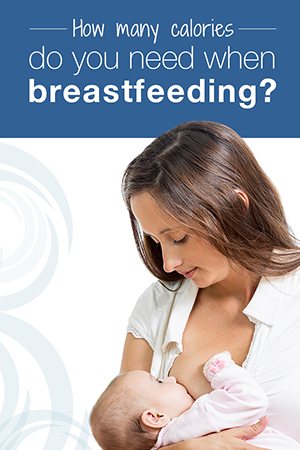
Many new mothers wonder if they need to consume more calories (also called energy) during breastfeeding, but the answer is no. You can take in the same number of calories that you did before becoming pregnant. This strategy helps with weight loss after birth.1
The Dietary Guidelines for Americans (DGAs) for caloric intake for all women 19 to 50 years old are based on activity level, as follows:2
- Sedentary: 1,800 to 2,000 calories per day
- Moderately active: 2,000 to 2,200 calories per day
- Active: 2,200 to 2,400 calories per day
The increased caloric need for women who are breastfeeding is about 450 to 500 calories per day.3 Women who are not trying to lose weight following pregnancy should supplement the above DGA calories per day by 450 to 500 calories. Often an increase in a normally balanced and varied diet is enough to meet your body's needs. Whether or not to increase caloric intake during breastfeeding is a decision that should be made with the assistance of a health care provider.
Poorly nourished mothers, those on vegan diets or other special diets, and those with certain health conditions may require a supplement of docosahexaenoic acid (DHA) in addition to multivitamins to ensure complete nutrition for breastfeeding.4
Women who are breastfeeding may have additional requirements for vitamins and minerals. Learn more about your specific nutritional needs during breastfeeding at ChooseMyPlate.gov.
Women also can use the U.S. Department of Agriculture's (USDA's) My Plate Daily Checklist for Moms to develop a personalized food plan based on their activity level, amount of breastfeeding, age, and other characteristics.
The estimated energy requirements (in calories per day) for infants are based on their age, size, and sex. Estimated energy requirements developed by the USDA are as follows:5
Males
- 1 to 3 months: 472 to 572 calories per day
- 4 to 6 months: 548 to 645 calories per day
- 7 to 9 months: 668 to 746 calories per day
- 10 to 12 months: 793 to 844 calories per day
Females
- 1 to 3 months: 438 to 521 calories per day
- 4 to 6 months: 508 to 593 calories per day
- 7 to 9 months: 608 to 678 calories per day
- 10 to 12 months: 717 to 768 calories per day
The above daily calorie ranges are for infants of a specific weight and length. The USDA has information on how to find out the daily calorie needs of your infant based on his or her size (PDF - 34 MB).
The USDA also has determined the daily protein, carbohydrate, and fat requirements for infants (PDF 34 MB).
Visit the Office on Women's Health's Breastfeeding page to learn what signs to watch for to determine whether your baby is getting enough breast milk.
The DGAs for infants increase as the infants get older. By the time that children are 2 to 3 years of age, daily calorie needs are 1,000 to 1,400 calories per day, depending on the child's activity level. For children who are older, see the 2015–2020 DGAs.
Citations
- U.S. Department of Health and Human Services Office on Women's Health. (2014).Your guide to breastfeeding. Retrieved June 1, 2016, from https://womenshealth.gov/your-guide-to-breastfeeding
- U.S. Department of Agriculture (USDA) & U.S. Department of Health and Human Services. (2015). 2015–2020 Dietary Guidelines for Americans (8th ed.). Retrieved January 28, 2016, from https://health.gov/our-work/food-nutrition/2015-2020-dietary-guidelines/guidelines/appendix-2/#table-a2-1
- American College of Obstetricians and Gynecologists. (2016). Breastfeeding your baby. Retrieved June 1, 2016, from http://www.acog.org/Patients/FAQs/Breastfeeding-Your-Baby
- American Academy of Pediatrics. (2012). Breastfeeding and the use of human milk. Pediatrics, 129(3), e827–e841. Retrieved April 27, 2012, from https://pediatrics.aappublications.org/content/129/3/e827
- USDA. (2009). Nutritional needs for infants. In Infant Nutrition and Feeding: A Guide for Use in the WIC and FSF Programs (11–40). Retrieved October 13, 2016, from https://wicworks.fns.usda.gov/wicworks//Topics/FG/CompleteIFG.pdf (PDF 3.4 MB)

 BACK TO TOP
BACK TO TOP